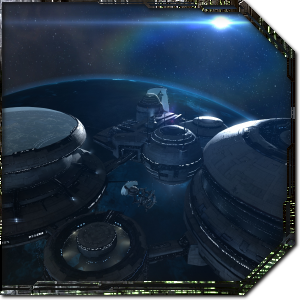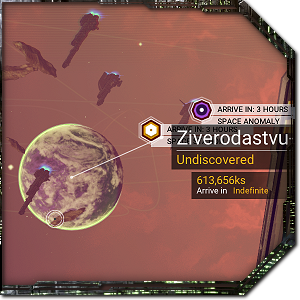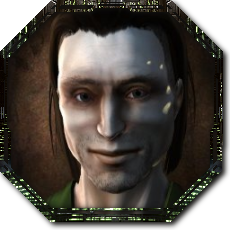
The biggest difference is that No Man’s Sky is an almost isolating singleplayer experience while EVE thrives on grand social gameplay. EVE‘s core design philosophy is to put thousands of players in a small box with limited resources and see what happens, but No Man’s Sky has a box of practically infinite size and no real resource scarcity or multiplayer interaction. Despite these huge differences, there are definite lessons that each game can learn from the other: No Man’s Sky could learn from EVE‘s hardcore difficulty and security rating system, and No Man’s Sky can teach EVE about the potential of untethered deep space exploration.
In this edition of EVE Evolved, I compare the procedural generation used in EVE Online and No Man’s Sky and look at some of the game design lessons each game can learn from its counterpart.
 Comparing procedural generation
Comparing procedural generation
No Man’s Sky is a masterpiece of procedurally generated content, but it turns out that this is really the only feasible way to create thousands of star systems. The EVE Online universe was generated procedurally over a decade ago using a disc accretion model to create 5,000 unique star systems, a process that the took computers of the day around 24 hours to complete. This star cluster was generated once and stored in a database, and new stars have been added to the cluster only a handful of times since then. The largest addition was in 2009’s Apocrypha expansion when 2,500 hidden wormhole systems were added to the game.
EVE‘s original generation method produced star systems with up to 14 planets in varying orbits that roughly mimic our own solar system, along with asteroid belts and stargates connecting each star system to a few of its neighbours. Every star was given an age, luminosity, spectral class, radius, and surface temperature, and every planet and moon has a laundry list of stats from mass and orbital distance to atmospheric pressure, surface temperature, and even escape velocity. While some of the planets and stars don’t conform to current models of stellar evolution, an attempt was made here to create a realistic universe.
No Man’s Sky‘s seems to use a simpler model (at least for the star system layout) that generates up to six planets and moons and then places them all extremely close to each other in order to make travel easier. You won’t find planets on the other side of the system’s star because the star is just a skybox rather than a physical object, and asteroids automatically spawn around the player when in space rather than being physically located in asteroid belts. It’s important to note that EVE Online‘s developers were trying to generate realistic star systems, while Hello Games focused on art and gameplay. No Man’s Sky even shines a spotlight on this discrepancy, suggesting that the universe the player inhabits is canonically a flawed or limited simulation. No Man’s Sky also generates star systems on the fly on the user’s computer rather than fetching information from a central server.
 No Man’s Sky could learn from EVE: Survival difficulty
No Man’s Sky could learn from EVE: Survival difficulty
Underneath its stylised visual aesthetic and 18 quintillion planets, No Man’s Sky‘s gameplay is that of a classic survival sandbox. Certain planets have harmful environments that you need special equipment to survive on, and you’ll spend a lot of time farming resources in order to upgrade or repair equipment and fuel your warp drive. This survival and progression gameplay is intoxicating for its first few hours but loses its appeal when it becomes clear that the actual challenge is negligible. All resources necessary for survival are abundant on every planet, and you can max out your ship and exosuit without even leaving your home planet. It’s here that I wish No Man’s Sky would take a leaf out of EVE Online‘s book and just take the training wheels off the bike.
I’d love to see a new Hardcore galaxy option with something similar to EVE Online‘s security rating system. Players could start off within an area that is totally safe, and then the difficulty would increase as they travel further from the starting location. Once you get far enough out, more planets would be barren and uncolonised, and they wouldn’t all be covered in copious amounts of Plutonium, Thamium 9, Zinc, and Platinum. Asteroids filled with ship fuel wouldn’t magically spawn in front of you in space, and not every star system would have a space station or freighters filled with minerals like pinatas in space. When you died in this galaxy, your ship would be destroyed and you would re-spawn on your starting planet, the challenge being to get as far from that system as possible. Add in a base that you can build on your home planet and tie progression to the security rating of systems and the survival gameplay would work a lot better.
 EVE could learn from No Man’s Sky: Deep space exploration
EVE could learn from No Man’s Sky: Deep space exploration
If No Man’s Sky has proven anything, it’s that pure exploration has an intense attraction to players. People are flying around this infinite cosmos like space photojournalists, taking snapshots of weird animals and amazing vistas to share with each other just for the sake of it. The early hours of No Man’s Sky are also filled with this intense feeling of discovery as you find crashed ships, abandoned outposts, ancient ruins filled with unsettling lore, and mining outposts staffed by stumpy reptiles with beaks. This kind of reminded me of the feeling we first got when wormholes opened in EVE Online, of being thrust into the unknown and trying to figure out who the Sleepers were and how everything worked.
This makes me kind of excited for the future direction of EVE, because we know that EVE is heading toward an ultimate goal of deep space exploration that will let players scan out and explore entirely new star systems. While these could be manually created by developers, it’s exciting to imagine that they could be procedurally generated on the fly when discovered. EVE‘s devs could make a new mechanic that lets players fling themselves on one-way trips into completely new star systems, each with a unique combination of planet types, resources, NPCs, exploration content, and maybe even lore. It would be up to the players to survive with whatever they brought with them, find out if the system is worth exploiting for resources, and try to find or build a stargate to enable two-way travel to the system.
While No Man’s Sky and EVE Online are worlds apart in terms of gameplay and scope, I think there are elements of both games that could help to improve the other. No Man’s Sky could be vastly improved with a security rating type system from EVE Online where the difficulty scales with distance travelled, for example, and it would be nice to have the option of a more challenging sandbox to play in.
At the same time, it’s possible that CCP Games could take some cues from No Man’s Sky‘s procedural generation when developing its own deep space exploration mechanics in years to come. No Man’s Sky has shown that the prospect of being the first person to explore the unknown is an intoxicating draw, and if any game is going to take this model and run with it, it’s got to be EVE Online.
 EVE Online expert Brendan ‘Nyphur’ Drain has been playing EVE for over a decade and writing the regular EVE Evolved column since 2008. The column covers everything from in-depth EVE guides and news breakdowns to game design discussions and opinion pieces. If there’s a topic you’d love to see covered, drop him a comment or send mail to brendan@massivelyop.com!
EVE Online expert Brendan ‘Nyphur’ Drain has been playing EVE for over a decade and writing the regular EVE Evolved column since 2008. The column covers everything from in-depth EVE guides and news breakdowns to game design discussions and opinion pieces. If there’s a topic you’d love to see covered, drop him a comment or send mail to brendan@massivelyop.com!















